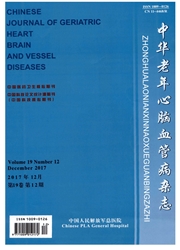

 中文摘要:
中文摘要:
目的 探讨在三维电解剖标测系统(CARTO)指导下经导管射频消融治疗心房颤动(房颤)的安全性和有效性。方法 将接受治疗的30例患者(阵发性房颤28例,持续性房颤2例)利用CARTO进行左心房重建后,对阵发性房颤患者行环绕同侧肺静脉的线性消融,射频消融终点为房颤终止且不能诱发;对持续性房颤患者进行左心房和冠状静脉窦的重建,标测射频消融复杂心房碎裂电位区,至房颤终止或行直流电转复。并检测其中16例阵发性房颤患者术后心脏生化标记物动态变化。结果 28例阵发性房颤均达到射频消融终点,2例持续性房颤患者中,1例在射频消融中转为窦性心律,1例行直流电转复。术后随访2~14(5.6±3.5)个月,25例患者无房颤复发,单次手术成功率83.3%。16例患者术后第1天肌钙蛋白T由术前的(0.01±0.00)ug/L升至(2.20±0.99)ug/I,(P〈0.01)。结论 在CARTO指导下射频消融治疗房颤安全有效,但肌钙蛋白T明显增高。
 英文摘要:
英文摘要:
Objective To evaluate the safety and efficacy of radiofrequency catheter ablation guided by 3-dimensional electroanatomic mapping system (CARTO)in treatment of patients with atrial fibrillation (AF). Methods Twenty-eight patients with paroxysmal AF and 2 patients with persistent AF were studied. Circumferential pulmonary vein (PV) ablation was performed for paroxysmal AF patients. The end points were complete PVs isolation and stopping of AF which could not be induced. For the 2 patients with persistent AF,areas associated with complex fractionated atrial electrograms (CFAEs) were identified and ablated. Levels of troponin-T (cTnT), creatinine kinase (CK) and hs isoform(CK-MB) were measured before and after the procedure in 16 paroxysmal AF patients. Results All the paroxysmal AF patients achieved the end points after ablation. Of the 2 persistent AF patients, 1 had AF terminated during ablation,and the other received direct current cardioversion after ablation. Small amount of perfcardial effusion was detected in one patient. After 5.6±3.5 months of follow-up, 25 patients were AF free,the success rate for single procedure was 83.3 %.The cTnT level at baseline was (0.01±0.00) ug/L,and was elevated to (2.20±0.99) ug/L (P 〈0.01) on the first day after ablation. Conclusion Radiofrequency catheter ablation of AF guided by CARTO is safe and effective, but cTnT elevates remarkably after ablation.
 同期刊论文项目
同期刊论文项目
 同项目期刊论文
同项目期刊论文
 期刊信息
期刊信息
